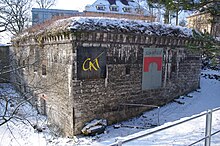Jazzkeller Sauschdall
The Ulm Jazzkeller Sauschdall (Swabian for pigsty) was opened in 1963 and is therefore one of the most traditional facilities of its kind. The club at Prittwitzstrasse 36 seats around 100 guests sitting and around 200 standing.
history
It was founded in 1963 by students from the then Ulm Engineering School, later the University of Applied Sciences, today Ulm University of Applied Sciences , after the AStA had already had a jazz advisor (at the time it was founded, Eberhard Lorenz ) and concerts had taken place in the engineering school's auditorium. After the ban on the student body in Baden-Württemberg, the Sauschdall is formally a department of the UStA eV, the independent student body of the Ulm University of Applied Sciences. In fact, the voluntary work is independent of membership in the university student body. The name goes back to the first location that was in the historic city center at the "Saumarkt". But water penetrated there with every heavy rain; therefore the student initiative moved to the current premises. These are located in a part of the former federal fortress Ulm , the fortress XX near the Ulm University of Applied Sciences.
The club had its peak as the most important event location in Ulm in the 1960s to 1980s, with a lot of folk music being played from 1973 onwards . The club was also known early on for its dance events. At the end of the 1980s a major renovation took place and in 1988 the CAT Cafe opened as another cultural department of the UStA in the ground floor part of the building. From the 1990s onwards, the Sauschdall increasingly faced competition from other venues in Ulm.
In the early 1990s, the club stopped its folk series. Hip-hop found its way into the program of the early 1990s . In the mid-1990s, the then Sauschdall makers, above all Merlin Bauer, were among the co-founders of Radio freeFM , the free radio in Ulm. In 1996, the movement group gathered around the later label makers of Heimelektro Ulm and several of the most important representatives of the electronic and post-rock scene of that time played in the Sauschdall jazz cellar . A financial crash occurred in 1998/99 and the Jazzkeller had to be temporarily closed.
It was thanks to the initiative of some college students and the Association of Friends and Supporters of the Jazzkeller Sauschdall that it was able to reopen in autumn 1999. The Ulm musician Reinhard Köhler, who was responsible for the program for the next two years, played a key role in getting the jazz cellar back on its feet. His successor Fred Wiegräfe, also a musician, resigned after a short time due to illness. Markus Grospietsch, Oliver Stauß, Robin Schmid, Johannes Tysiak and Jörg Emmert followed as program designers. Florian Wieland was responsible for the program until the summer of 2012, working with a focus on avant-garde jazz , modern creative , contemporary jazz and peripheral areas. A program group around Philipp Zey and Uwe Duckgeischel that has been working since summer 2012 is dedicated to traditional jazz .
Since the autumn 2011 program, the so-called Sunday concerts, a series of songwriters and pop concerts that had previously been based in the neighboring CAT Cafe for a few years under the name of Sofakonzerte, have been included in the program as a regular series.
In the Jazzkeller everything that has a reputation in European, partly and international jazz has played, partly before these bands and musicians could only be seen in large halls. A few examples here are Jan Garbarek , Wolfgang Dauner , Charlie Mariano , Jean-Luc Ponty , Chet Baker , Albert Mangelsdorff , John McLaughlin , Manfred Schoof , Barbara Dennerlein , Volker Kriegel , Joachim Kühn , Charly Antolini , Dollar Brand , Alexander von Schlippenbach , Tim Berne , Ingrid Laubrock and Mary Halvorson . In the early days there were also radio broadcasts of jazz concerts by the Süddeutscher Rundfunk and Bavarian Radio .
Organization and program
Since its foundation, the Jazzkeller has been run exclusively by unpaid volunteers, mostly young people, among whom, however, the students have been in the minority for many years. The program with regular concerts and events several times a week in spring and autumn focuses on modern, contemporary jazz and its peripheral areas.
Web links
- Website of the Jazzkeller Sauschdall
- The booze on Facebook
- Friends of Jazzkeller Sauschdall on Facebook
Individual evidence
- ↑ Jazz in Ulm, Jazzzeitung 2001
- ↑ Heimelektro Ulm, de: Bug # 32
- ↑ Heimelektro Ulm - progressive pop music from in beat ween, LESSON # 9
- ↑ Augsburger Allgemeine, October 2012, Young Jazz in the Old Walls
- ^ Augsburger Allgemeine, September 2011, Fortress of the Joy of Experimentation
- ↑ Augsburger Allgemeine, October 2011, Gripping with and against one another
- ^ Augsburger Allgemeine, April 2011, Jazz without blinkers
Coordinates: 48 ° 24 ′ 37 " N , 9 ° 59 ′ 41.5" E
